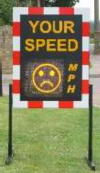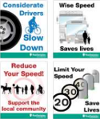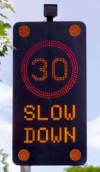Speed management
Ways we measure speeding on our roads, and steps we (or Parish/Town Councils) might take to make them safer.
West Berkshire Council has a responsibility to make sure our roads are safe. The speed of traffic on our roads is one of the main factors in fatal incidents. We work with the police and local parish and town councils to introduce measures to help keep speeds within safe limits.
We've explained some of these speed management measures below.
Speed limits
Changes to speed limits, or the introduction of new limits, are considered by a task group consisting of West Berkshire Council officers, local councillors and the police.
You can find out more about changes to speed limits and requesting changes on our speed limits on local roads page.
We also publish a list of .
Speed intervention programme
Before tackling an issue with speeding, we need to work out exactly what the problem is and how it happens. We do this by gathering speed data. The data we collect allows us to make an informed decision about a solution or potential next steps.
Speed data is collected using different types of equipment. Some equipment is operated by West Berkshire Council, and others operated by parish councillors.
The equipment that might be used includes:
- Speed Indicator Devices (SIDs): these can be loaned to parish councillors and partners to gather speed data
- Temporary posters: a set of four posters are available, designed with road safety messages
- Vehicle Activated Signs (VAS): used as warning signs to reduce the risk of an incident occurring
- Speed Data Recorders (SDR): non-contact, covert traffic monitoring devices
- Community Speedwatch (CSW): an educational programme run by the police
Our Speed Intervention Programme flowchart shows how we might decide which equipment to use and when:
If the speeding is on a road with a speed limit up to 40mph, during the day and it's suitable to deploy data collecting equipment, the Local Authority (LA) signposts complainants to their Parish Council to undertake work using the Speed Indication Device (SID).
Captured data will be downloaded by the Traffic and Road Safety Team and analysed. This data is shared with the Parish Council.
Or:
If the speeding is on a road with a speed limit up to / over 40mph, during hours of darkness (or if the SID is not suitable to be deployed), the The Traffic and Road Safety Team will deploy the Speed Data Recorder (SDR).

If the data indicates an issue, the Speed Data Recorder (SDR) may be deployed to gather data 24/7 over a period of time.

If the SDR data indicates a problem with inappropriate speed, the following may be installed:
Speed Indication Device Trigger <10%  | Temporary posters Trigger >10%  | Temporary vehicle activated signs Trigger >15%  | Hybrid SID Trigger >20%  | Community speed watch (CSW) |

A further deployment of a SDR can then be used to measure a change in driver behaviour.

Where these measures have failed to achieve a change, the next option is either enforcement /speed cameras (responsibility of the police) or engineering/traffic calming. Traffic calming will only be considered as a last option and only where there is a history of injury accidents which are attributed to speed.




